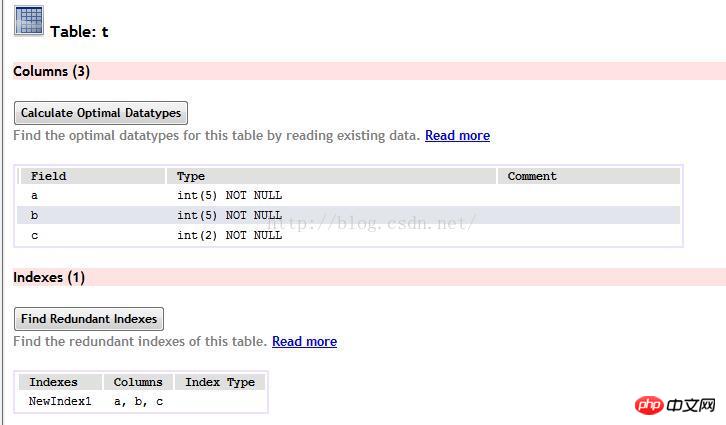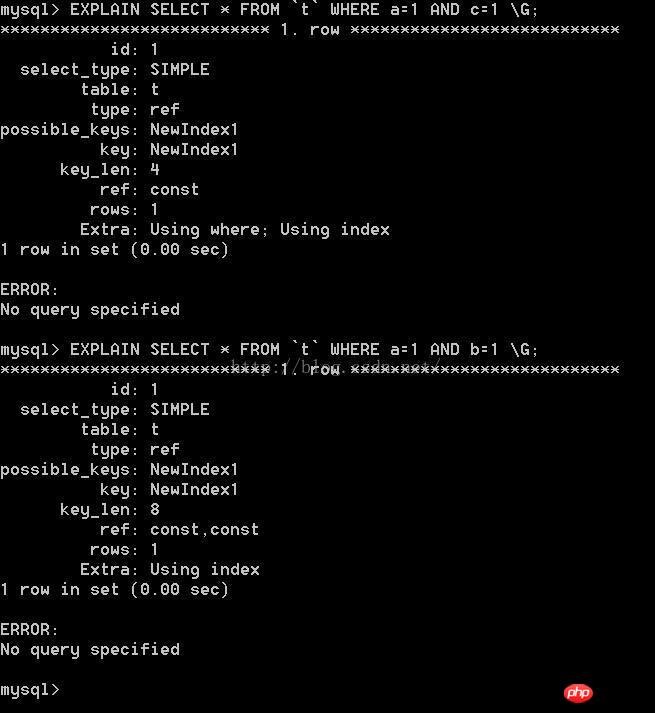Details of calculating index length in MySQL
First, let’s look at a question. For table t, it contains three fields a, b, c. Assuming that their default values are not empty, now create a combined index index (a, b, c) analysis What is the difference between select * from t where a=1 and c=1 and select * from t where a=1 and b=1?
First create the table

##Execute these two items respectively Statement

It is found that the difference between the two is mainly in key_len. Why are the differences between the two different?
My understanding is:
We can think of the combined index as the first-level directory, the second-level directory, and the third-level directory of the book, such as index(a,b,c) is equivalent to a being a first-level directory, b being a second-level directory under the first-level directory, and c being a third-level directory under the second-level directory. To use a directory, you must first use its superior directory, except for the first-level directory.
So
where a=1 and c=1 only uses the first-level directory, c is in the third-level directory, no If you use the second-level directory, then the third-level directory cannot be used
where a=1 and b=1 only use A first-level directory and a second-level directory.
So the key_len of the second query is larger.
#But how is key_len calculated? How do we calculate 4 and 8 above? I haven’t paid much attention to it before. When analyzing the performance of SQL query statements through explain, I paid more attention to select_type, type, possible_key, key, ref, rows, and extra this time. I feel it is necessary to clarify the calculation of key_len.
1. For all index fields, if not null is not set, one byte needs to be added.
#2. Fixed-length field, int occupies four bytes, date occupies three bytes, and char(n) occupies n characters.
#3. For the field varchar(n), there are n characters + two bytes. 4. Different character sets, the number of bytes occupied by a character is different. In latin1 encoding, one character occupies one byte, in gbk encoding, one character occupies two bytes, and in utf8 encoding, one character occupies three bytes.
can be derived
where a=1 and c= For 1, key_len=4
where a=1 and c=1, key_len=4+4=8
# Now let’s do another question, Create a t2 table, the data structure is as follows

##Please execute explain select * from t2 where name="001 " and id=1 \G; What is the key_len?
Analysis key_len=4+5*1+2=11, because the fields are not null, the int type is 4 bytes, and varchar(5) occupies 5 characters + 2 Bytes, one character of latin1 encoding table occupies 1 byte, so varchar(5) occupies 7 bytes. The structure is as shown below
Because MySQL has a query optimizer, for where a=1 and c=1 type queries, fields The order has no effect, the query optimizer will optimize automatically. where c=1 and a=1 will be optimized to where a=1 and c=1, but it is recommended to use where
a=1 and c=1, for easy understanding and query buffering. Because query buffering and hashkey values are calculated based on SQL statements and are case-sensitive, when writing SQL statements, try to keep them consistent to prevent the same query from being cached multiple times. ##
Supplement

Hot AI Tools

Undresser.AI Undress
AI-powered app for creating realistic nude photos

AI Clothes Remover
Online AI tool for removing clothes from photos.

Undress AI Tool
Undress images for free

Clothoff.io
AI clothes remover

Video Face Swap
Swap faces in any video effortlessly with our completely free AI face swap tool!

Hot Article

Hot Tools

Notepad++7.3.1
Easy-to-use and free code editor

SublimeText3 Chinese version
Chinese version, very easy to use

Zend Studio 13.0.1
Powerful PHP integrated development environment

Dreamweaver CS6
Visual web development tools

SublimeText3 Mac version
God-level code editing software (SublimeText3)

Hot Topics
 MySQL: An Introduction to the World's Most Popular Database
Apr 12, 2025 am 12:18 AM
MySQL: An Introduction to the World's Most Popular Database
Apr 12, 2025 am 12:18 AM
MySQL is an open source relational database management system, mainly used to store and retrieve data quickly and reliably. Its working principle includes client requests, query resolution, execution of queries and return results. Examples of usage include creating tables, inserting and querying data, and advanced features such as JOIN operations. Common errors involve SQL syntax, data types, and permissions, and optimization suggestions include the use of indexes, optimized queries, and partitioning of tables.
 MySQL's Place: Databases and Programming
Apr 13, 2025 am 12:18 AM
MySQL's Place: Databases and Programming
Apr 13, 2025 am 12:18 AM
MySQL's position in databases and programming is very important. It is an open source relational database management system that is widely used in various application scenarios. 1) MySQL provides efficient data storage, organization and retrieval functions, supporting Web, mobile and enterprise-level systems. 2) It uses a client-server architecture, supports multiple storage engines and index optimization. 3) Basic usages include creating tables and inserting data, and advanced usages involve multi-table JOINs and complex queries. 4) Frequently asked questions such as SQL syntax errors and performance issues can be debugged through the EXPLAIN command and slow query log. 5) Performance optimization methods include rational use of indexes, optimized query and use of caches. Best practices include using transactions and PreparedStatemen
 Why Use MySQL? Benefits and Advantages
Apr 12, 2025 am 12:17 AM
Why Use MySQL? Benefits and Advantages
Apr 12, 2025 am 12:17 AM
MySQL is chosen for its performance, reliability, ease of use, and community support. 1.MySQL provides efficient data storage and retrieval functions, supporting multiple data types and advanced query operations. 2. Adopt client-server architecture and multiple storage engines to support transaction and query optimization. 3. Easy to use, supports a variety of operating systems and programming languages. 4. Have strong community support and provide rich resources and solutions.
 How to connect to the database of apache
Apr 13, 2025 pm 01:03 PM
How to connect to the database of apache
Apr 13, 2025 pm 01:03 PM
Apache connects to a database requires the following steps: Install the database driver. Configure the web.xml file to create a connection pool. Create a JDBC data source and specify the connection settings. Use the JDBC API to access the database from Java code, including getting connections, creating statements, binding parameters, executing queries or updates, and processing results.
 How to start mysql by docker
Apr 15, 2025 pm 12:09 PM
How to start mysql by docker
Apr 15, 2025 pm 12:09 PM
The process of starting MySQL in Docker consists of the following steps: Pull the MySQL image to create and start the container, set the root user password, and map the port verification connection Create the database and the user grants all permissions to the database
 MySQL's Role: Databases in Web Applications
Apr 17, 2025 am 12:23 AM
MySQL's Role: Databases in Web Applications
Apr 17, 2025 am 12:23 AM
The main role of MySQL in web applications is to store and manage data. 1.MySQL efficiently processes user information, product catalogs, transaction records and other data. 2. Through SQL query, developers can extract information from the database to generate dynamic content. 3.MySQL works based on the client-server model to ensure acceptable query speed.
 Laravel Introduction Example
Apr 18, 2025 pm 12:45 PM
Laravel Introduction Example
Apr 18, 2025 pm 12:45 PM
Laravel is a PHP framework for easy building of web applications. It provides a range of powerful features including: Installation: Install the Laravel CLI globally with Composer and create applications in the project directory. Routing: Define the relationship between the URL and the handler in routes/web.php. View: Create a view in resources/views to render the application's interface. Database Integration: Provides out-of-the-box integration with databases such as MySQL and uses migration to create and modify tables. Model and Controller: The model represents the database entity and the controller processes HTTP requests.
 How to install mysql in centos7
Apr 14, 2025 pm 08:30 PM
How to install mysql in centos7
Apr 14, 2025 pm 08:30 PM
The key to installing MySQL elegantly is to add the official MySQL repository. The specific steps are as follows: Download the MySQL official GPG key to prevent phishing attacks. Add MySQL repository file: rpm -Uvh https://dev.mysql.com/get/mysql80-community-release-el7-3.noarch.rpm Update yum repository cache: yum update installation MySQL: yum install mysql-server startup MySQL service: systemctl start mysqld set up booting






